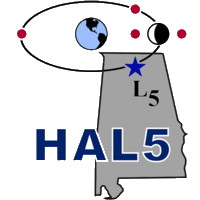
Project High-Altitude Lift-Off (HALO): Sky Launch 1 (SL-1)
Third Time's the Charm. Making History off the Coast of North Carolina.

After the success of GL-1, Project High-Altitude Lift-Off (HALO) kicked into high gear for our first launch
attempt on March 22, 1997. Due to prelaunch malfunction, the first launch attempt was scrubbed.
The second attempt, on May 3 was scrubbed due to weather.
Finally...HAL5 made amateur rocketry history on Sunday, May 11, 1997 from
from a grass strip airfield just north of Hampstead, North Carolina, about a mile west of Topsail Beach:
[34.39639, -77.665]. This first HALO mission is dedicated to the memory of Edward F. Stluka.
At 8:25 AM EDT, HAL5's Project HALO team performed the first amateur rockoon mission when it successfully launched its Sky Launch 1 rocket from a high altitude balloon.
SL-1 rocket ascended to approximately 36 nautical miles.
HALO that day conducted the world's first high altitude ignition of a hybrid rocket. It is
the highest flight of a hybrid rocket at that time. Based on an estimated rocket apogee
between 30 abd 36 nautical miles, HAL5 also claimed the world record for highest altitude
achieved (at that time) by an amateur rocket, and a hybrid rocket of any kind.
That day, HAL5 proved to the world that small groups can accomplish great things and made space a little closer to all of us.
The record made into the 2000 Guinness Book of World Records under Amateur Rocketry. Due to avionics glitches, no precise final altitude was
recorded. However, Greg Allison (Project HALO Manager at the time) indicated that the balloon's
camera showed the curvature of the earth and "black sky." Based on the manufacture's estimated balloon burst altitude, and approximate burn time of the rocket, some belived we may have hit much higher than 36 nautical miles. HAL5's record stood until 2004 when Civilian Space eXploration Team (CSXT) achieved 72
miles.
When and Where
Dates:- Site survey was held on Friday afternoon, May 9, 1997
- Site setup was held all day Saturday, May 10, 1997
- Rockoon mission was performed on Sunday, May 11, 1997
- Site setup began on Saturday morning at 10:30 a.m. EDT
- Launch operations began early Sunday about 3:30 a.m. EDT
- Balloon launch occurred after Sunrise at 6:59 a.m. EDT
- Rocket launch occurred at 8:25 a.m. EDT
- Grass field in Hampstead, NC, along US highway 17 on east North Carolina coast
- Today (2017), it is surrounded by houses.
Purpose of Project HALO
The purpose of Project HALO is to make access to space more affordable for students, amateurs, experimenters, and researchers. It is combination technical and educational program. The program is divided into several phases. All phases have opportunities for student involvement at all grade levels.
- Phase 0 was for developing rocket subsystems and testing them on the ground and at high altitude.
- Phase 1 is to build the rocket and successfully launch it from a balloon.
- Phase 2 will be to develop the operational capability for inexpensive and routine access to space using rockoons.
Goals of HALO Sky Launch 1
Project HALO Sky Launch 1 marks the completion milestone for Project HALO Phase 1, Proof of Concept. As such, this successful launch was the final test for Project HALO to proceed onto Phase 2, Operational Rockoons, when we can start to launch student payloads.
| GOALS OF HALO SKY LAUNCH 1 | STATUS |
|---|---|
| Primary Goals of HALO Sky Launch 1 | |
| Launch the balloon without damaging the balloon, gondola, or rocket | ACHIEVED |
| Maintain the temperature inside the oxidizer tank to high altitude | ACHIEVED |
| Successfully launch the rocket from the balloon | ACHIEVED |
| Verify computer predictions using data transmitted from rocket | FAILED |
| Benefits of Meeting Primary Goals | |
| Gain confidence to proceed onto Project HALO Phase 2 | ACHIEVED |
| Have one success from which to approach potential donors and clients | ACHIEVED |
| Honors from Meeting Primary Goals | |
| First amateur group to have a successful rockoon mission | ACHIEVED |
| Important data point for future hybrid rockoons | ACHIEVED |
| Important data point for hybrid upper stages | ACHIEVED |
| World Records for HAL5 | ACHIEVED |
| Highest altitude achieved by an amateur rocket (by any means) | ACHIEVED |
| Highest altitude achieved by an amateur rockoon | ACHIEVED |
| Highest altitude achieved by an hybrid-motor rocket (any organization) | ACHIEVED |
| Highest altitude achieved by an amateur hybrid-motor rocket | ACHIEVED |
| Secondary Goals of HALO Sky Launch 1 | |
| Have the rocket exceed an altitude of 50 nautical miles (nmi) | FAILED |
| Have the rocket exceed an altitude of 100 kilometers (km) | FAILED |
| Recover the rocket | FAILED |
| Recover the balloon gondola | FAILED |
| Benefits of Meeting Secondary Goals | |
| Have one success from which to approach potential donors and clients? | ACHIEVED |
| Can place the recovered rocket in a museum? | FAILED |
| Can inspect recovered rocket and/or gondola for damage? | FAILED |
| Can recover valuable electronics for future reuse | FAILED |
| Honors from Meeting Secondary Goals | |
| First amateur group to get their own rocket into space | FAILED |
| First group (amateur or professional) to get a hybrid rocket into space | FAILED |
| First amateur rocket recovered from space | FAILED |
| Potential Records from Getting into Space | SOME |
| Least expensive rocket-to-space program, start to first flight (less than $20,000 (1997 USD)) | |
| Least expensive rocket space mission, manufacturing and operations (less than $8,000 (1997 USD)) | |
Technical Details





Reports and Press Releases

March 22, 1997. First Attempt --- scrubbed due to prelaunch malfunction
- Pre-Attempt HAL5 Press Release (text)
- Post-Attempt HAL5 Press Release (text)
- Article by Tim Pickens -- Rocket Systems Lead
- Article by Greg Allison -- HALO Program Manager
- Pre-Attempt HAL5 Press Release (text)
- Article by Tim Pickens -- Rocket Systems Lead
- Pre-Attempt HAL5 Press Release (text)
- Post-Attempt HAL5 Press Release (text)
- Article by Tim Pickens -- Rocket Systems Lead
- Article by Larry Scarborough -- Balloon Gondola Lead
- Article by Peter Ewing
- Article by Gene Young
- Article by Greg Allison -- HALO Program Manager
- Article by Bill Brown -- Balloon Systems Lead
- Article by Ben Frink
- Article by John McCallum
- Article by Ron Creel
- Editorial by Steve Unger
- Article by Steve Mustaikis
Amateur Radio Frequencies and Telemetry Decoding
Transmissions from the Balloon Gondola- Live Color Video -- 434.00 MHz AM ATV -- (Cable Ready TV Channel 59)
- Live Black & White Video -- 1280 MHz FM ATV
- APRS GPS Packet Data -- 441.050 MHz FM
- Talk-in Frequency at launch site is on 144.34 MHz Simplex
- Talk-in Frequency at launch site is also on 147.21 MHz Simplex repeater
- Also listen to the 146.82 Wilmington repeater (88.5 PL)
See Bill Brown's WB8ELK Home Page for details.

